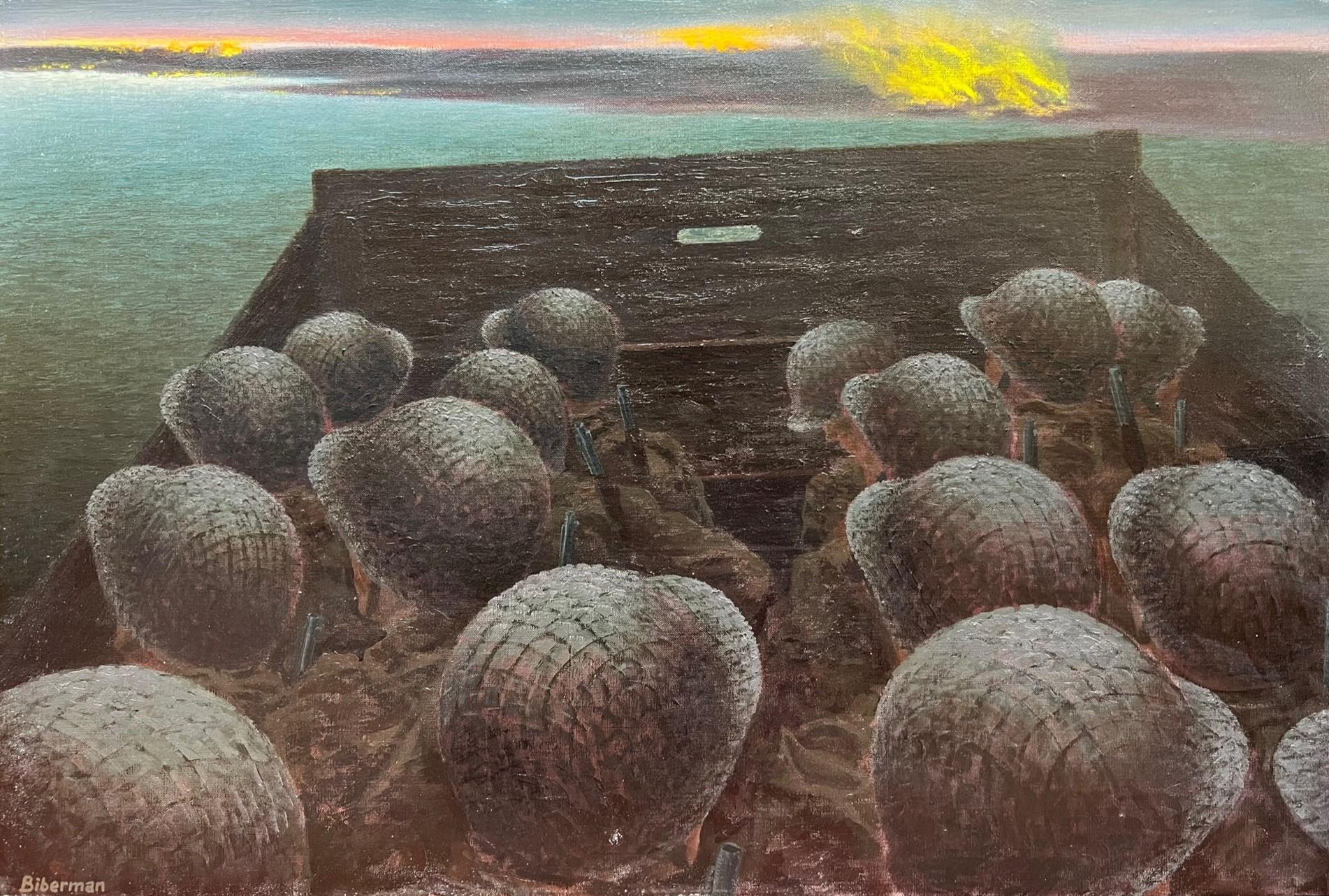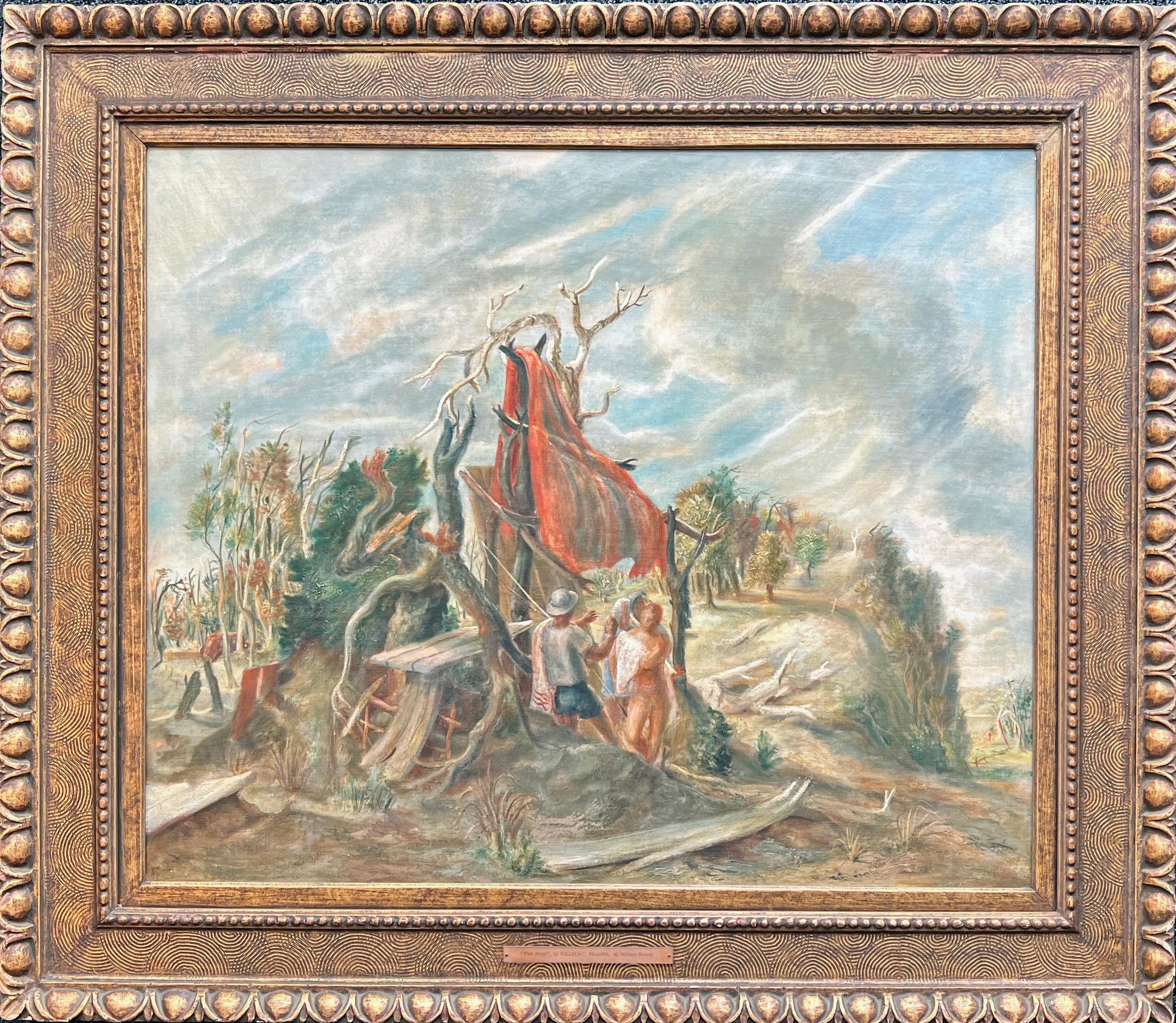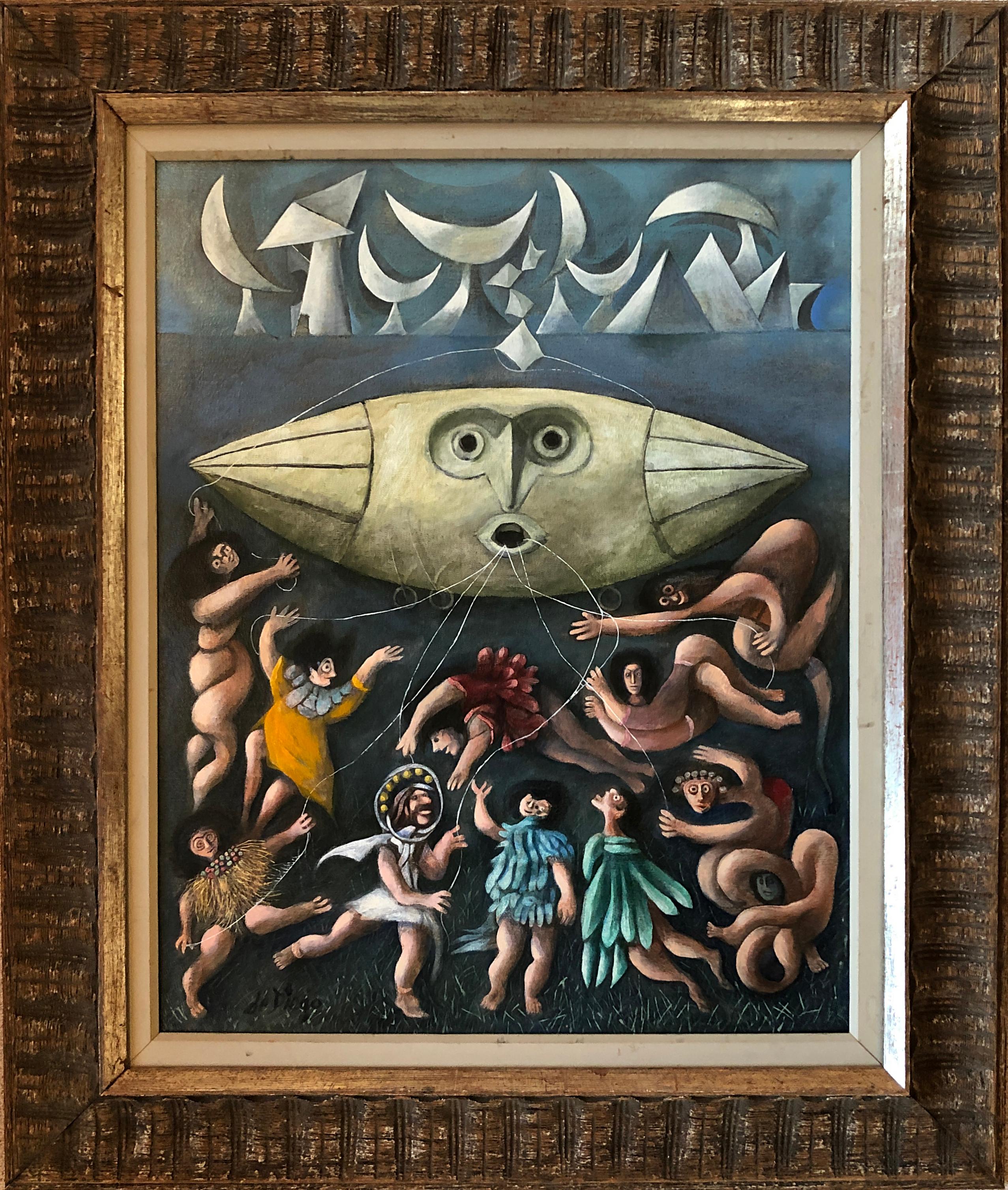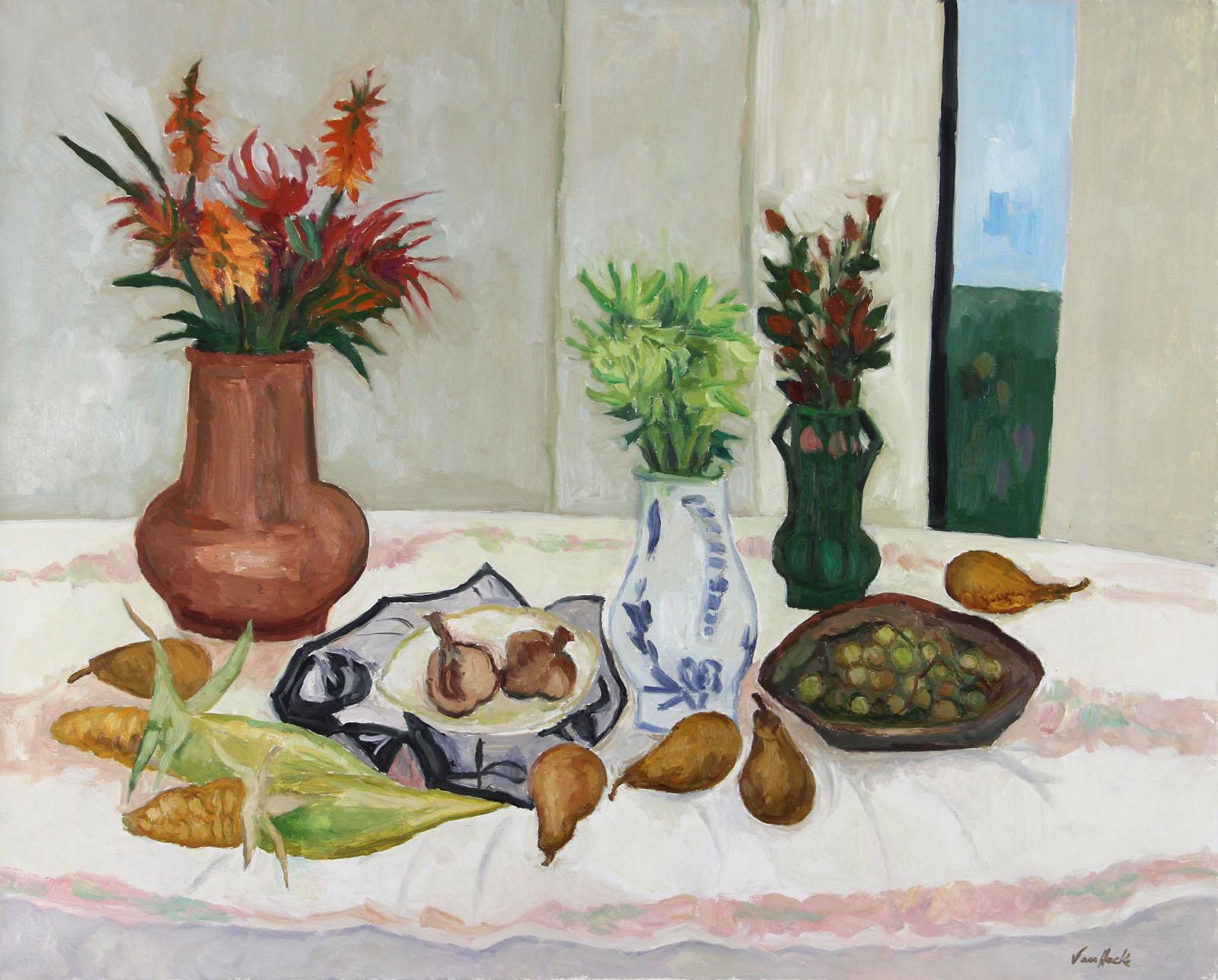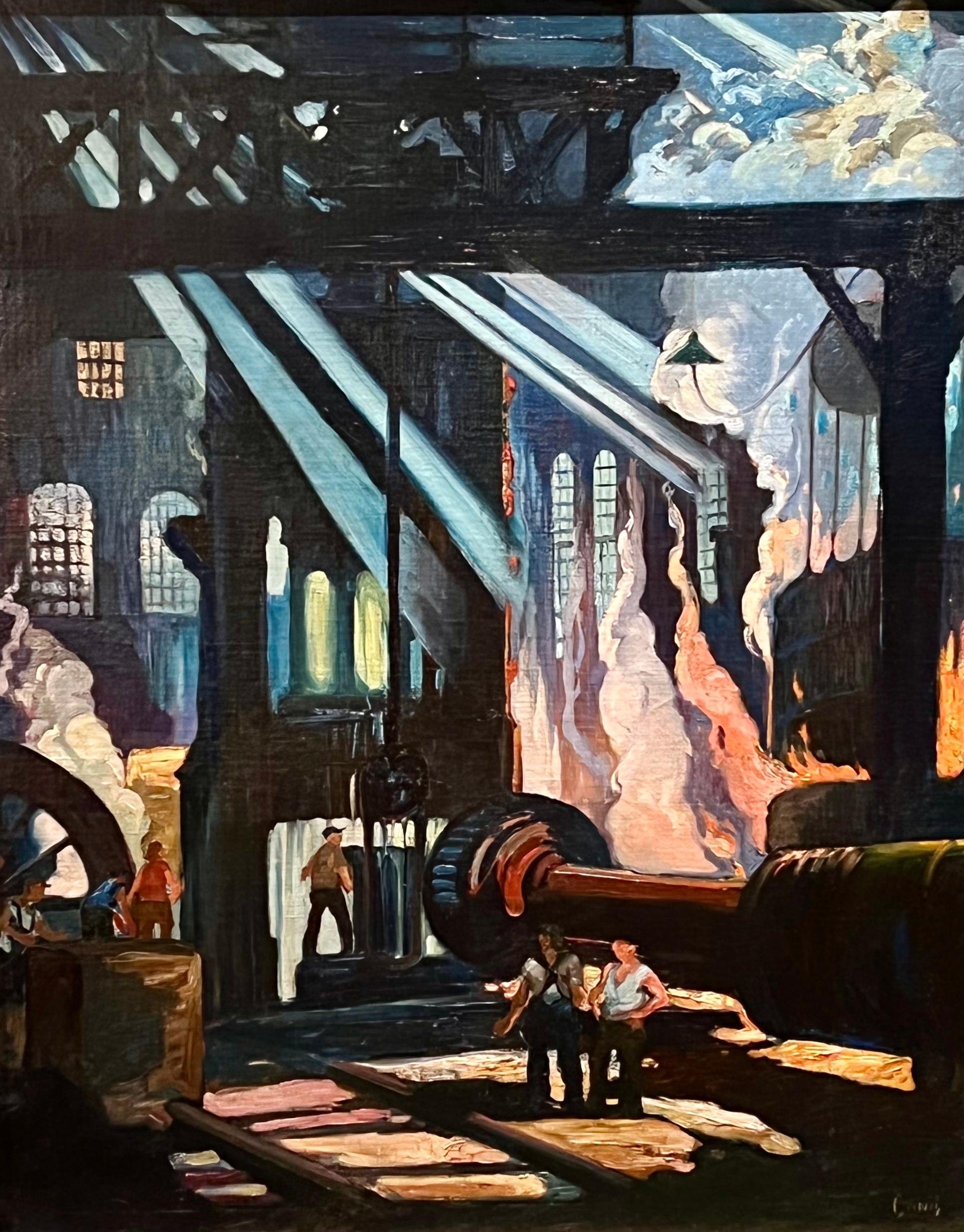Items Similar to The Old World
Want more images or videos?
Request additional images or videos from the seller
1 of 5
Russell CowlesThe Old Worldby 1943
by 1943
About the Item
Old World, by 1943, oil on canvas, signed lower right, 43 ½ x 30 ½ inches, artist’s name and title inscribed verso; exhibited 1) Romantic Painting in America, Museum of Modern Art, New York, NY, November 17, 1943 – February 6, 1944, no. 59; 2) Recent Paintings by Russell Cowles, Kraushaar Galleries, New York NY, March 27 – April 15, 1944 (see a) Cowles at His Best in Ten New Exhibits, The Art Digest, April 1, 1944, p. 16 – “But then, Cowles can be romantic also. Woodland Magic and Old World each in their own way, win this denotation. The first goes so far in the direction of visionary beauty as to call to mind R. L. Newman, in certain passages of ruddy coloration; the second is a vision of ruin, of a crumbling monotonic promontory down which rides an old man and his old horse, and is of this day’s vision – none other.” and b) Devree, Howard, A Reviewer’s Notes Brief Comment on Some Recently Opened Shows – Paintings by Russell Cowles, The New York Times, April 2, 1944 – “One of the outstanding one-man shows of the season is made up of ten paintings – recent oils by Russell Cowles, at Kraushaar’s . . . Except for “Old World,” a dramatic comment on our time which was included in the “Romantic” exhibition at the Museum of Modern Art, and the “Snake Charmer,” included in the recent Whitney annual, none of the ten canvases has been shown before.”) 3) One Hundredth and Fortieth Annual Exhibition of Painting and Sculpture, Pennsylvania Academy of Fine Arts, Philadelphia, PA, January 19 – February 15, 1945, no. 108 (label verso); literature: 1) Miller, Dorothy C. and Thrall, James, Romantic Painting in America, The Museum of Modern Art (1943), p. 133; and 2) Bear, Donald, Russell Cowles, Dalzell Hatfield, designed by Merle Armitage, no. 327 of 1000 copies (1946), plate no. 12, ex collection Kraushaar Galleries (New York) and Dalzell Hatfield Galleries (Los Angeles), presented in its original frame.
This work is part of our exhibition America Coast to Coast: Artists of the 1940s.
Russell Cowles' Old World is a critically acclaimed and well exhibited painting which also serves as a poignant historical record of World War II. Cowles presents to disasters of the war in Europe through the metaphor of a beleaguered old man riding atop a sway-backed horse on the verge of stepping off a cliff into oblivion. The man looks to the rear apprehensively as if running away from some unseen evil force while a vulture looks on in the foreground at the ensuing calamity. The craggy outcropping, punctuated lighting and stormy sky in the background add to the drama. Though devoid of the explicit mayhem of combat, it is hard to imagine a more clear statement against the horrors of war.
Cowles was an eclectic painter who recalled, “I like to paint everything. I want to take the whole field of life. Art is an expression of the human spirit and it finds an endless variety of outlets, all the way from a Chinese landscape of the Tang Period . . . to a religious painting by El Greco to a ‘Guernica’ by Picasso ." A native of Iowa, which Cowles recalled was a “cultural desert,” the young artist’s first exposure to painting was through his mother, who had studied at the Art Institute of Chicago. Cowles graduated from Dartmouth College in 1909 and then decamped to Paris to paint until his money ran out. He made it back to the United States in time for the Armoy Show in 1913 which disturbed and influenced his art in equal measure. After additional time at the Art Student’s League and the National Academy of Design, Cowles was awarded the Prix de Rome to study at the American Academy in Rome, where he stayed for five years, being deeply immersed in the Old Masters.
Upon his return to the United States, Cowles took up a deeper examination of modernism, while the 1920s found him traveling back to Paris and across Asia, soaking up varied influences. In his absence, one of his paintings was awarded the Norman Waite Harris Medal and Prize at the Art Institute of Chicago. After returning to the United States, Cowles moved to Santa Fe where he associated with the painters of the New Mexico group. Cowles later split time between New York City and his farm in Connecticut.
He exhibited extensively during his career, including at the Pennsylvania Academy of Fine Arts, the Salons of America, the Art Institute of Chicago, the Metropolitan Museum of Art, the Museum of Modern Art, the Whitney Museum of American Art, the Los Angeles County Museum of Art, and the Legion of Honor in San Francisco. He was honored with over forty solo exhibitions and was represented by major art dealers on both coasts, including Kraushaar Galleries in New York City and Dalzell Hatfield Gallery in Los Angeles. Cowles is listed in Who Was Who in American Art and all other standard references.
- Creator:Russell Cowles (1887-1979, American)
- Creation Year:by 1943
- Dimensions:Height: 43.5 in (110.49 cm)Width: 30.5 in (77.47 cm)Depth: 3 in (7.62 cm)
- More Editions & Sizes:43.5 x 30.5 inchesPrice: $18,000
- Medium:
- Movement & Style:
- Period:
- Condition:
- Gallery Location:Los Angeles, CA
- Reference Number:1stDibs: LU1859214250602
About the Seller
No Reviews Yet
Vetted Seller
These experienced sellers undergo a comprehensive evaluation by our team of in-house experts.
1stDibs seller since 2022
6 sales on 1stDibs
Typical response time: 8 hours
- ShippingRetrieving quote...Ships From: Los Angeles, CA
- Return PolicyA return for this item may be initiated within 3 days of delivery.
More From This SellerView All
- Six O'ClockLocated in Los Angeles, CASix O-Clock, c. 1942, oil on canvas, 30 x 20 inches, signed and titled several times verso of frame and stretcher (perhaps by another hand), marked “Rehn” several times on frame (for the Frank K. M. Rehn Galleries in New York City, who represented Craig at the time); Exhibited: 1) 18th Biennial Exhibition of Contemporary American Oil Paintings from March 21 to May 2, 1943 at The Corcoran Gallery of Art in Washington, D.C. #87, original price $450 (per catalog) (exhibition label verso), 2) Craig’s one-man show at the Frank K. M. Rehn Galleries, New York City, from October 26 to November 14, 1942, #10 (original price listed as $350); and 3) Exhibition of thirty paintings sponsored by the Harrisburg Art Association at the State Museum of Pennsylvania in Harrisburg in March, 1944 (concerning this exhibit, Penelope Redd of The Evening News (Harrisburg, Pennsylvania) wrote: “Other paintings that have overtones of superrealism inherent in the subjects include Tom Craig’s California nocturne, ‘Six O’Clock,’ two figures moving through the twilight . . . .” March 6, 1944, p. 13); another label verso from The Museum of Art of Toledo (Ohio): original frame: Provenance includes George Stern Gallery, Los Angeles, CA About the Painting Long before Chris Burden’s iconic installation outside of the Los Angeles County Museum of Art, Urban Light, another artist, Tom Craig, made Southern California streetlights the subject of one of his early 1940s paintings. Consisting of dozens of recycled streetlights from the 1920s and 1930s forming a classical colonnade at the museum’s entrance, Burden’s Urban Light has become a symbol of Los Angeles. For Burden, the streetlights represent what constitutes an advanced society, something “safe after dark and beautiful to behold.” It seems that Craig is playing on the same theme in Six O-Clock. Although we see two hunched figures trudging along the sidewalk at the end of a long day, the real stars of this painting are the streetlights which brighten the twilight and silhouette another iconic symbol of Los Angeles, the palm trees in the distance. Mountains in the background and the distant view of a suburban neighborhood join the streetlights and palm trees as classic subject matter for a California Scene painting, but Craig gives us a twist by depicting the scene not as a sun-drenched natural expanse. Rather, Craig uses thin layers of oil paint, mimicking the watercolor technique for which he is most famous, to show us the twinkling beauty of manmade light and the safety it affords. Although Southern California is a land of natural wonders, the interventions of humanity are already everywhere in Los Angeles and as one critic noted, the resulting painting has an air of “superrealism.” About the Artist Thomas Theodore Craig was a well-known fixture in the Southern California art scene. He was born in Upland California. Craig graduated with a degree in botany from Pomona College and studied painting at Pamona and the Chouinard Art School with Stanton MacDonald-Wright and Barse Miller among others. He became close friends with fellow artist Milford Zornes...Category
1940s American Modern Landscape Paintings
MaterialsCanvas, Oil
- The Landing/Dawn LandingLocated in Los Angeles, CAThis painting is part of our exhibition America Coast to Coast: Artists of the 1940s. The Landing/Dawn Landing, 1944, oil on canvas, signed lower left, 20 x 30, titled verso; exhib...Category
1940s American Modern Paintings
MaterialsCanvas, Oil
- Untitled (Elevated Platform)Located in Los Angeles, CAThis painting is part of our current exhibition - America Coast to Coast: Artists of the 1940s Untitled (Elevated Platform), 1950, oil on canvas, signed and dated lower right, 30 x...Category
1950s American Modern Paintings
MaterialsCanvas, Oil
- Riders of Pigeon HillBy Jon CorbinoLocated in Los Angeles, CARiders of Pigeon Hill, c. 1940s, oil on canvas, signed lower right, 24 x 36 inches, label verso with title, artist’s name and address; same information inscribed verso; ex-collection...Category
1940s American Modern Paintings
MaterialsCanvas, Oil
- The DemogogueLocated in Los Angeles, CAThe Demagogue or Tale in a Tub, 1952, oil on canvas, 20 x 24 inches, signed, titled, and dated verso About the Painting The Demagogue is an iconic Bendor Mark painting from the prime of his post-war period. Beginning early in his career, Mark was fascinated with depictions of the human figure and their capacity to tell stories of the world around him. Mark was a keen observer of his times and in The Demagogue we see Mark’s portrayal of a faithless politician holding up a “V” for victory sign as he appeals to the wanton desires and prejudices of the masses. Below the demagogue is a swirl of humanity representing the common man who is being pushed down by the powerful, while the robed figure of liberty with her scales of justice held high is brushed aside. Behind the demagogue, Mark places two other powerful supporting institutions which were often co-opted by the world’s dictators, the Church and the Military. Mark was an internationalist, so it is difficult to know exactly which demagogue inspired him to create this work, but in 1952 there were many to choose from. Whether depicting Argentina’s Peron (the demagogue and the women to the right resemble Juan and Eva Peron), Spain’s Franco or the United States’ homegrown fear mongers like Joseph McCarthy, Mark tells a universal story that unfolded in dramatic fashion during the post-war period as nations and their peoples grappled with authoritarianism and anti-democratic impulses. Stylistically, The Demagogue draws on the elements which make Mark’s work from this period immediately recognizable, a saturated palette, a closely packed and frenetic composition, exaggerated figuration and stylized facial features. But, above all, we see Mark’s ability to tell the stories of the rich and powerful and their ability to oppress. Like Mark’s work in the collection of the Whitney Museum of American Art (The Hourglass - 1950-51) and the Los Angeles County Museum of Art (Execution – 1940), The Demagogue pulls no punches, as the artist lays bare the threats to freedom and basic human rights. About the Artist Bendor Mark was an American modernist and social realist painter. Born as Bernard Marcus on June 5, 1912, in Brooklyn, New York, Mark trained at The Cooper Union during the 1920s where he studied with William Brantley van Ingen and became a prize-winning artist with a focus on painting the human figure. After his time at Cooper, Mark continued to live in New York and worked as a commercial artist and textile designer in addition to his pursuit of a career in painting. Like many Depression Era artists, Mark engaged with social progressives and in 1934, he joined the Artist’s Union which had the goal of advancing artists’ position as “worker.” Mark’s painting, Restaurant, which is now in the permanent collection of the Smithsonian American Art Museum, appeared in the February 1936 edition of the Union’s publication, Art Front, as part of a review of an exhibition at ACA Gallery in New York. Mark worked on the Federal Art Project and by the mid- to late-1930s, began a series of paintings exploring the working conditions and hazards of the mining industry. Mark believed that miners were “in the forefront of the struggle for emancipation” and that the mere “struggle for existence is like moving mountains.” He became passionate about the Spanish Civil War and painted sympathetic images in support of the Spanish Republic. Mark was a premature anti-fascist and throughout his career painted works critical of dictators and other oppressors. During the late 1930s, Mark entered mural competitions with designs influenced by the Mexican muralists, taught adult art education in Queens, New York, and was an instructor at the WPA’s Queensboro Art Center. He was so committed to socially progressive art that by 1934, he had changed his name to Bendor Mark, in part, to distinguish his social realist paintings from his earlier work. During World War II, Mark worked as an artist for military contractors. After the war, he was employed as a graphic artist and in the printing industry before moving to Southern California in 1948, where he returned to a fine art practice the following year with politically and socially charged images which reflected his view of the shortcomings of the post-War period, the continued threat of fascism, and the international tensions of the Cold War. As the mood of the country shifted towards the right during the McCarthy Era and the art world’s attention focused on abstraction at the expense of figuration, Mark’s career as a painter suffered. From the 1950s through the 1980s, Mark continued to depict the events that shaped the world around him, often employing a highly stylized approach characterized by dynamic multi-figure compositions, a subtle muted palette, and exaggerated expressive features. A review of Mark’s oeuvre suggests that few people escaped Mark’s attention. He painted presidents, prime ministers, royalty, evangelists, musicians, and dictators (and their henchman), along with miners, farm workers, the urban poor, protesters, the unemployed and dispossessed. He laid bare the arrogance, cruelty, and hypocrisy of the world’s elites. Mark noted, “A work of art cannot be fully appreciated or wholly understood without considering the socio-political and cultural ambience that gave it birth.” He continued, “I have the ability to foresee the direction of social and political events while they are actually taking place.” He was not himself a direct political activist, however. Although Mark commented, “It’s a misconception to separate art from the social aspect of life,” he viewed artists as being neutral. According to Mark, “An apolitical attitude reflects the fact that the artist is passive. . . An artist never affects society; he merely reflects it.” In addition to the Mexican Muralists, Mark was influenced by the old masters Rembrandt, Michelangelo, and Masaccio, as well as the more modern master, Van Gogh. Mark’s writings directly acknowledge these influences and archival material from his estate includes magazine articles, pamphlets and transparencies related to these artists. Mark also collected materials related to several of his social realist contemporaries, including Reginald Marsh, Ben Shahn, Leonard Baskin, and Raphael Soyer, who was Mark’s good friend. For years, Soyer sent Mark holiday cards and Soyer inscribed a message of friendship on a self-portrait he gifted to Mark in the 1970s, all of which are still held in the collection of Mark’s family. From the late 1920s through the mid-1950s, Mark’s work was well received. His paintings won prizes and were accepted into major juried exhibitions including at the Brooklyn Museum, the New York World’s Fair and the Metropolitan Museum of Art. He gained national recognition for paintings depicting the oppressed and the common worker. Despite the decline in popularity of representational art during the 1950s and 1960s, Mark stayed true to his interest in depicting the human figure and by the last two decades of his life, his work underwent a reassessment as curators included Mark’s paintings in exhibitions showcasing the role of labor in art during the Depression Era. This recognition continued in recent years when Mark was honored by having his work included in the Whitney Museum of American Art’s ground-breaking exhibition, Vida Americana, which explored the pioneering role that the Mexican muralists played in the development of modern American art during the inter-war period. The influence of Rivera, Siqueiros and Orozco on Mark is unmistakable and his paintings from the 1950s (and beyond) sit comfortably in dialogue with other Los Angeles artists who continued to paint in the social realist tradition long after the mainstream art world had moved toward abstraction. Mark’s concern for underserved Brown and Black communities was shared with artists such as Charles White and his ally, Edward Biberman...Category
Mid-20th Century American Modern Figurative Paintings
MaterialsCanvas, Oil
- Gold Mine, Central City, ColoradoBy Joseph MeertLocated in Los Angeles, CAThis painting is part of our exhibition America Coast to Coast: Artists of the 1930s Goldmine, Central City, Colorado, oil on canvas, 36 x 28 inches, c. 1936, signed lower right, ex collection of Platt Fine Art, Chicago, Illinois (label verso). About the Painting Joseph Meert’s painting, Goldmine, Central City, Colorado, depicts the short-lived resurrection of a once prominent city just outside Denver. Central City was founded in 1859 soon after John Gregory struck gold in the area. As word spread, thousands of miners converged into “Gregory’s Gulch” and its surroundings became known as the “richest square mile on earth.” Mining production quickly increased resulting in Central City to becoming Colorado’s largest city in the early 1860s. Despite some technical difficulties transitioning to lode mining and the rise of competition from Leadville, Central City remained an economic boom town through the turn of the century. But, with every boom, there is a bust. World War I marked the end of Central City’s prominence as ore production ground to a halt and by 1925, the town’s population shrank to only 400 people. The desperation of the Great Depression and a nearly 100% increase in the price of gold lured labor and capital back to Central City. Meert painted in Colorado during the mid-1930s, a time when he created his most desirable works. It is during this period of renaissance that Meert captures one of Central City's outlying dirt streets bordered by 19th century wooden houses from the town's heyday and the more recently installed electric lines leading to a distant gold mine. A lone figure trudges up the hill, a mother with a baby in her arms, putting us in mind of the rebirth of the town itself. Meert had solo exhibitions at the Colorado Springs Fine Arts Center in 1936 and the Denver Art Museum. Although it is not known whether Goldmine, Central City was included in either of these exhibitions, it seems likely. Moreover, the painting is closely related to Meert’s painting, The Old Road, which was painted in 1936 and exhibited at the Corcoran Gallery of Art in Washington, DC and at the Dallas Museum of Art. About the Artist Joseph Meert was a well-regarded painter and muralist, who initially made a name for himself in the American Scene and later as an abstract expressionist. Although initially successful, Meert struggled financially and with mental illness later in life. He was born in Brussels, Belgium, but moved with his family to Kansas City, Missouri. As a child, a chance encounter at the Union Pacific Railyard changed his life. Meert happened upon a worker repainting and stenciling a design on a railroad car. Meert later recalled that this experience introduced him to the idea of being a painter. Without support from his father, Meert obtained a working scholarship to the Kansas City Art Institute. After four years at the Kansas City Art Institute, Meert studied seven years at the Art Students League and in Europe and Los Angeles. At the Art Students League, Meert fell under the spell of Thomas Hart Benton and Stanton MacDonald-Wright. In 1931, he befriended Jackson Pollock. By 1934, Meert was part of the Public Works of Art Project when he met his wife, Margaret Mullin...Category
1930s American Modern Landscape Paintings
MaterialsCanvas, Oil
You May Also Like
- 20th century oil painting entitled The Unknown CornerLocated in London, GBCollections: Robert Isaacson; James Draper, New York, 2014. Exhibited: Cambridge, The Fitzwilliam Museum, Beggarstaffs: William Nicholson and James Pr...Category
Early 20th Century Modern Figurative Paintings
MaterialsCanvas, Oil
- Fish Story oil painting by Williams Charles PalmerLocated in Hudson, NYThis painting is illustrated in the Catalogue of the 1945 Encyclopedia Britannica Collection of Contemporary American Painting, p.84. Written and edited by Grace Pagano. "Painting ...Category
Mid-20th Century American Modern Figurative Paintings
MaterialsOil, Canvas
- Lords of the Sky oil painting by Julio De DiegoBy Julio de DiegoLocated in Hudson, NYLords of the Sky (c.1950) Oil on canvas, 30" x 24" 40" x 34" x 2" framed Provenance: The Artist, his daughter About this artist: Julio De Diego crafted a formidable persona within ...Category
Mid-20th Century Modern Figurative Paintings
MaterialsCanvas, Oil
- Fruits, maïs et raisinsLocated in LE HAVRE, FRArthur VAN HECKE (1924-2003) Fruits, maïs et raisins Oil on canvas Size: 81 x 100cm Signed lower right Painting in perfect condition, sold unframed. Origin: - Artist's studio - Mar...Category
1990s Modern Figurative Paintings
MaterialsCanvas, Oil
- Industrial Mid-20th Century WPA Modern Men Working American Scene Social RealismLocated in New York, NYIndustrial Mid-20th Century WPA Modern Men Working American Scene Social Realism George Pearse Ennis (American, 1884-1936) "Forging a Gun Tube #1...Category
1910s American Modern Interior Paintings
MaterialsCanvas, Oil
- The SwingBy Will BarnetLocated in New York, NYSigned lower right: Will Barnet; on verso (photo available): Will Barnet / Aug 1963Category
Late 20th Century American Modern Figurative Paintings
MaterialsCanvas, Oil
Recently Viewed
View AllMore Ways To Browse
Gary Zack Vase
George Kozmon
Vintage Original Expressionist Art
Bill Howard
Namibia Canvas
Dune Grasses
Valentino Acrylic
Scott Wilson
Never Against Virginia
Bluebell Wood
Irish Princess
Mary Sims Artist
1940s Opera Glasses
Mexican Baroque Painting
Color Block Early 1900s
Victoria Harbor
Barneys Display
Guy Benard Painting

